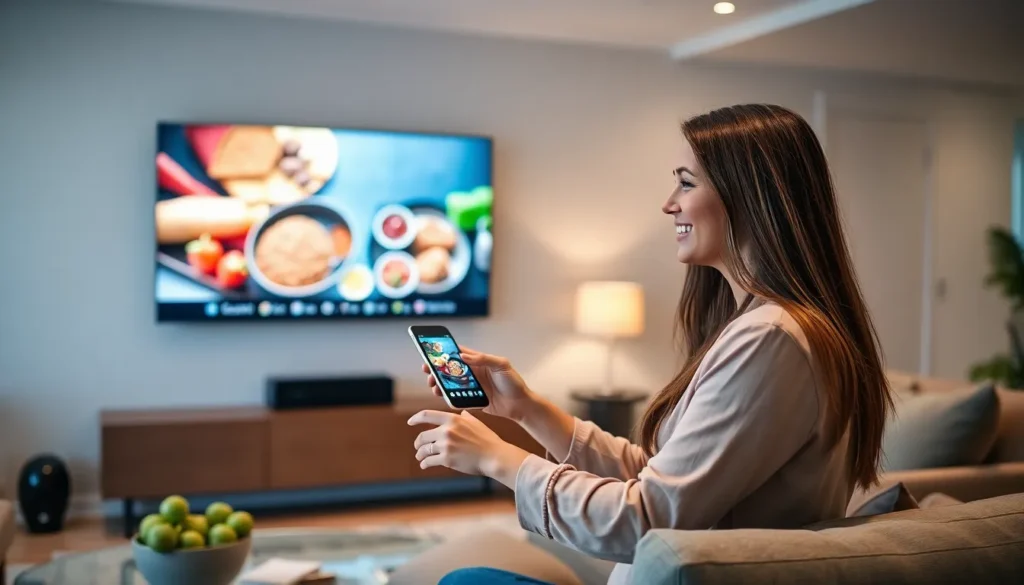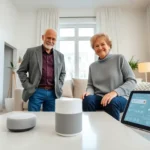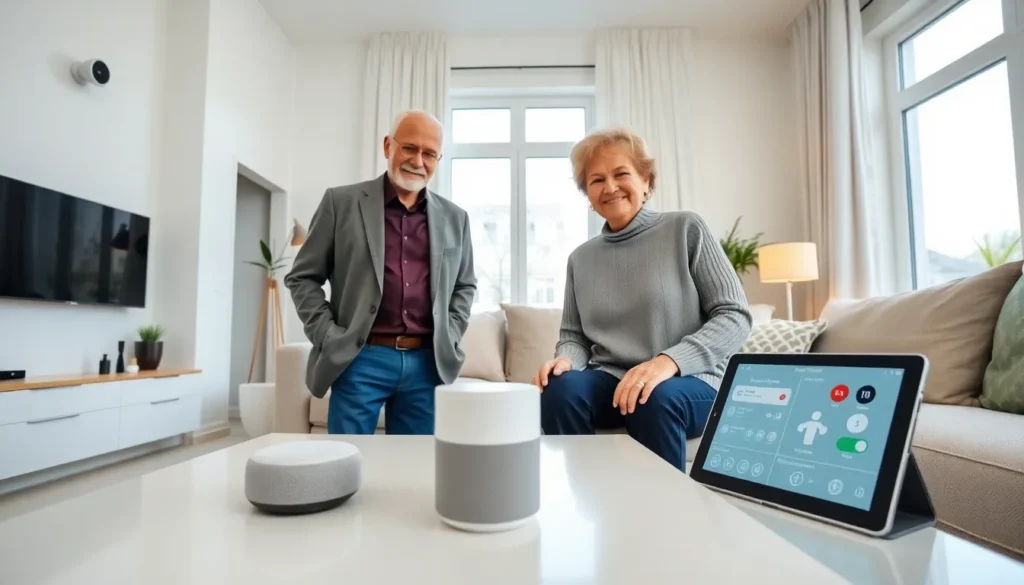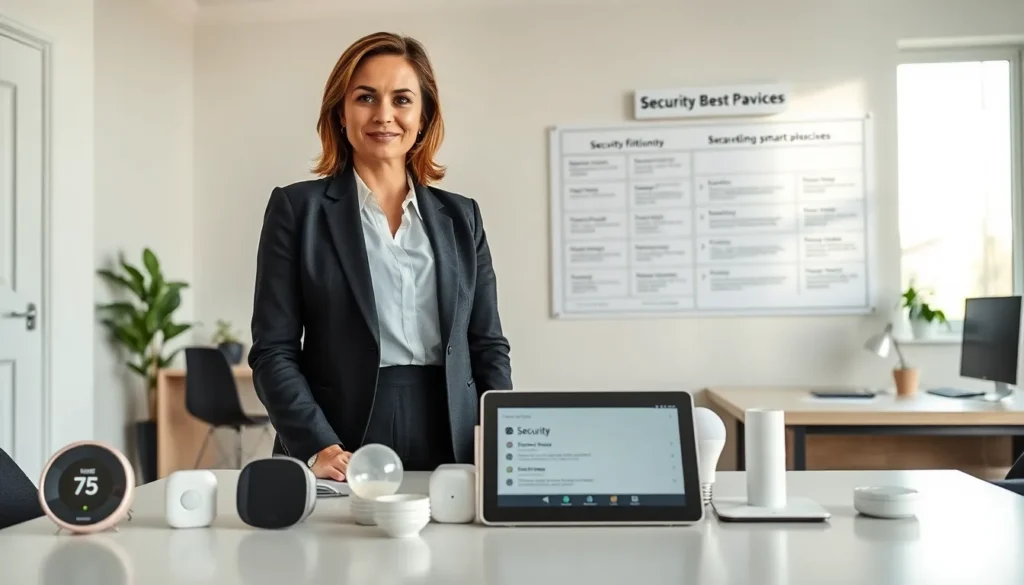In a world where screens are as common as coffee shops, smart screen displays are the dazzling stars of the show. These tech-savvy wonders don’t just sit pretty; they transform everyday experiences into interactive adventures. Imagine controlling your home with a simple swipe or glancing at a recipe while your hands are knee-deep in dough. It’s like having a personal assistant who doesn’t judge your cooking skills!
Table of Contents
ToggleOverview of Smart Screen Displays
Smart screen displays serve as multifunctional devices that integrate advanced technology into daily life. These displays blend touchscreen functionality with internet connectivity, allowing users to interact seamlessly. During cooking, for example, users can access recipes without handling devices, maintaining a clean workspace.
Variety in smart screen displays caters to diverse needs. Many units can serve as digital photo frames, security monitors, or virtual assistants. Brands like Google and Amazon offer smart displays that support voice commands, offering hands-free operation.
Enhanced user interfaces contribute to the appeal of smart screens. Most products feature intuitive layouts, ensuring easy navigation through apps and content. By integrating smart technology within the home, these displays can control lighting, temperature, and entertainment systems, leading to a more streamlined lifestyle.
Interconnectivity remains a hallmark of smart displays. Integration with other smart home devices facilitates cohesive control from a single interface. Users can monitor security cameras, adjust thermostat settings, or request information with simple directives.
Market growth showcases the popularity and versatility of smart screen displays. The global market expects to reach over $15 billion by 2025, reflecting widespread adoption. Consumers increasingly prioritize devices that enhance convenience while providing entertainment and functional benefits.
With continuous advancements in technology, the future of smart screen displays looks promising. Innovations may enhance AI capabilities, making these devices even more interactive and personalized. Features like advanced voice recognition and facial recognition could elevate user experience further.
Key Features of Smart Screen Displays

Smart screen displays feature several standout characteristics that enhance their functionality and user experience.
Touch Interaction
Touch interaction allows users to navigate efficiently. Touchscreen technology enables simple taps, swipes, and pinches for effortless control. Users can quickly access apps or browse content without relying on remote controls. This intuitive design fosters seamless engagement, making it easier for individuals to complete tasks. Furthermore, touch interaction appeals to various age groups, ensuring accessibility for seniors and tech-savvy youths alike.
High-Resolution Displays
High-resolution displays provide crisp visuals and vibrant colors. Known for their ability to showcase photos, videos, and streaming content in stunning detail, many models feature 1080p or 4K resolution. Such clarity elevates user experience, whether for entertainment or presentations. Brands recognize the importance of display quality, shaping product offerings to meet consumer demands for immersive visual experiences. Additionally, enhanced brightness and color accuracy contribute to greater viewing satisfaction.
Connectivity Options
Connectivity options enable users to link devices effortlessly. Smart screen displays typically support Wi-Fi and Bluetooth connections for convenience. These options allow seamless integration with smartphones, tablets, and other smart devices. Users can stream music, conduct video calls, or control smart home functions without hassle. Many displays also feature HDMI and USB ports, adding versatility for external devices. By offering robust connectivity, manufacturers ensure these displays meet the diverse needs of modern households.
Benefits of Using Smart Screen Displays
Smart screen displays offer a multitude of advantages that enhance user interaction and enrich daily life. Their multifaceted nature caters to a range of activities, making them essential tools in modern homes and businesses.
Enhanced User Experience
User experience significantly improves with smart screen displays. Intuitive interfaces allow for easy navigation, empowering users with quick access to information and functionalities. High-resolution visuals deliver stunning clarity and vibrant colors, ideal for both entertainment and productivity. Voice interaction further elevates convenience, enabling hands-free operation. With the ability to customize settings to personal preferences, users enjoy a tailored experience that meets their unique needs. Overall, these displays make information access effortless and enjoyable.
Versatility in Applications
Applications of smart screen displays are varied and practical. These devices seamlessly function as digital photo frames, enhancing home decor while displaying cherished memories. In kitchens, they serve as cooking assistants, displaying recipes and instructional videos. Smart security systems benefit from incorporation, allowing monitoring of home environments from a centralized interface. Schools utilize them for interactive learning, engaging students with dynamic content. Businesses leverage smart displays for presentations, video conferencing, and information sharing, streamlining operations and enhancing collaboration. Their adaptability makes smart screens valuable assets across numerous settings.
Popular Smart Screen Display Brands
Leading brands in the smart screen display market include Amazon, Google, and Apple. Amazon’s Echo Show series exemplifies versatility, offering models with various screen sizes and enhanced features like built-in cameras for video calls. Google Nest Hub models focus on smart home integration, providing seamless control over connected devices and access to Google Assistant.
Samsung stands out with its Smart Display line, delivering high-resolution screens with vibrant colors. Known for cutting-edge technology, Samsung combines excellent visual performance with robust app support, ensuring that users enjoy an expansive range of functionalities. Lenovo’s Smart Display series emphasizes a sleek design coupled with superior audio quality, making it ideal for entertainment purposes.
LG enters the scene with its webOS platform, featuring a user-friendly interface that enables easy navigation. This brand integrates AI capabilities to enhance user experience, personalizing content suggestions based on user preferences. Huawei’s display products target both home and business environments, leveraging their innovative technology for effective communication and collaboration.
TCL’s smart displays offer budget-friendly options without compromising quality. Its integration with popular streaming services makes entertainment accessible and enjoyable. The brand’s dedication to improving user experience with responsive touch screens showcases its commitment to customer satisfaction.
Each brand brings unique features and benefits, catering to different user needs. Consumers prioritize functionality, design, and ease of use when selecting smart screen displays. With the market projected to exceed $15 billion by 2025, these brands are well-positioned to meet growing demand and expectations as technology continues to advance.
Future Trends in Smart Screen Displays
Advancements in artificial intelligence will likely transform smart screen displays into more intuitive devices. Enhanced voice recognition capabilities enable more responsive interactions, making it easier for users to access information and control devices hands-free. Expectations for facial recognition technology could lead to personalized experiences, tailoring content based on user identity.
Evolving user interfaces are expected to feature adaptive layouts, optimizing display elements based on user preferences and habits. Integration with augmented reality will create immersive experiences, enriching education, gaming, and remote collaboration. Enhanced connectivity through 5G networks promises faster data transfer, boosting streaming quality and interactive features.
Market analysts predict that sales of smart screen displays could surpass $15 billion by 2025, driven by increasing consumer demand for smart home integration. Emerging technologies like gesture control may allow users to interact with displays using simple hand movements, paving the way for a more seamless experience. Manufacturers are exploring new materials and screen technologies, resulting in ultra-thin, flexible displays that adapt to various environments.
Sustainability trends are influencing design choices, with brands incorporating eco-friendly materials and energy-efficient technologies. Companies are expected to enhance privacy features, addressing growing concerns over data security and user consent. Consumers can anticipate devices that not only perform efficiently but also prioritize environmental responsibility.
Popular brands are continually innovating to stay competitive in this dynamic market. For example, Amazon is likely to improve its voice assistant capabilities in future models, while Google may focus on deeper integration with its ecosystem. As competition heats up, each company aims to deliver unique features and improved functionalities, ensuring their smart screen displays meet evolving consumer expectations.
Smart screen displays are revolutionizing the way individuals interact with technology in their daily lives. Their multifunctionality and user-friendly interfaces make them indispensable tools for both personal and professional use. As advancements in AI and connectivity continue to emerge, these devices are poised to become even more integral to modern living.
With their ability to streamline tasks and enhance experiences, smart screen displays cater to a wide range of needs. The future promises exciting developments that will further enrich user interaction and convenience. As consumers embrace these innovations, the smart screen display market is set to thrive, shaping the future of home and office environments alike.













